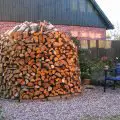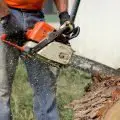An old-fashioned ax or a powerful chainsaw are your two options if you’re out cutting down a tree or splitting firewood. The only thing they have in common is the capacity to cut wood. You might be debating between using an ax or a chainsaw and wondering which is preferable. It depends on what you’re attempting to accomplish.
There are a number of situations where an axe might be preferable to a chainsaw, such as cutting at roots that are close to the ground or felling limbs. But if you want to finish the work fast, a chainsaw is preferable for crosscutting through thicker branches and trunks. It quickly cuts through the thickest tree trunks and efficiently handles big chunks of firewood.
Since axes have been around for thousands of years and are still a prevalent instrument, they must have a purpose. They are excellent for fitness, maybe safer, considerably less expensive, and require much less upkeep. Each tool is better suited for certain jobs and tasks.
In this article, we’ll discuss everything you need to know about axes vs chainsaws, comparing them along with which you should use and when!
Table of Contents
- Axe vs. Chainsaw
- Axe vs. Chainsaw Comparison
- Which Is Best for Splitting Wood?
- Which Is Best for Felling Trees?
- FAQs (Frequently Asked Questions)
Axe vs. Chainsaw
| Ax | Chainsaw | |
|---|---|---|
| Power Source | Manual | Motor |
| Speed | Slow | Fast |
| Maintenance Requirements | Low | High |
| Price | Low | High |
| Safety Danger | Moderate | High |
| Versatility | High | Moderate |
| Ease of Use | Moderate | Moderate |


Axe vs. Chainsaw: Which Is Better?
When deciding which instrument to use, you should probably consider a few variables even though the chainsaw is quicker and will produce cleaner cuts with less wasted wood. Of course, you’ll probably have both tools in your tool shed if you cut a lot of wood. The following are some of the criteria to take into account:
- Power Source
- Cutting speed
- Maintenance/upkeep requirements
- Price
- Safety
- Versatility
- Ease of Use
Since the two instruments handle various types of operations differently, the type of job you’re doing is obviously the most crucial factor to take into account. Neither tool is superior; it all depends on what you want to do with it.
Axe vs. Chainsaw Comparison
Power Source
Since an ax is a manual tool, many people love using them, and if you swing one for a few hours, you’ll get great exercise. It’s a great strength-based exercise for your back, arms, and chest, as well as a great cardiovascular workout. According to Men’s Journal, splitting or chopping wood might result in an hourly calorie burn of 400–500. The fact that the ax doesn’t consume gasoline as a chainsaw may also make you prefer it.
If you’re concerned about avoiding the usage of fossil fuels, this may matter especially. Even if chainsaws don’t consume a lot of gas, some fuel is better than none. A chainsaw, on the other hand, has a motor and burns fuel, so it has much greater cutting power than a single swing of an ax and requires much less of your energy to operate (although chainsaws are heavy and can be tiring as well). Although you’ll spend less time trimming, you can spend more money on fuel.
Speed
Due to its ability to quickly cut through wood, the chainsaw is clearly preferred. A chainsaw will typically chop through a tree much more quickly than an ax, depending on the user. The majority of chainsaws can operate at a maximum RPM of between 10k and 14k. You’ll discover that it takes a lot longer to cut through a tree trunk because your ax can only move as quickly as you can.
Axes are much better suited to cutting down just one or a few smaller trees. It’s also better suited to clearing out smaller brush or splitting logs along the grain if you’re cutting firewood. Since axes are usually a lot lighter than a chainsaw, you might even go faster with an ax if you’re only trying to chop off limbs of trees.
Maintenance Requirements
A chainsaw will need a lot more upkeep than an ax does, just like any tool with moving parts and a motor. Cleaning and occasional honing of the blade are the essential components of axe maintenance. Even though you might need to repair the handle from time to time, keeping a chainsaw is still less labor.
For chainsaws to function at their best, the following are the minimum requirements:
- Keep it lubricated
- Regularly sharpen the blades
- Chain removal and cleaning of parts
- Use new gas with the right mixture
If you use your chainsaw frequently, you’ll need to give it more regular maintenance because it will need new gas more frequently, the blades will dull more frequently, and it may start cutting to the side. None of these jobs will take up a lot of your time, but they may increase your workload if you’re not particularly careful about maintaining your tools.
Price
It will usually cost you between $50 and $100 to buy a nice ax, and unless you need to buy a new handle, it won’t cost you much more in the long run. Due to its low cost, practically everyone can add an ax to their tool collection.
On the other side, chainsaws are significantly more expensive. The least expensive models will cost roughly $150, and their cost will increase from there based on their size and feature set. The slight price premium for a high-quality saw like one from Husqvarna is well worth it. The fuel, oil, and equipment required to keep it sharp and working properly will also cost money.
Safety
Whether you employ either of them safely is dependent on your level of experience. There are several different safety measures on contemporary chainsaws, such as:
- Throttle-lock: prevents the throttle from accidentally engaging while the lock is not pushed.
- Easy stop control: enables you to quickly brake the saw blade.
- Chain catch: collects shattered or errant chains
- Handguard: hand protection against broken chains made of plastic
Despite everything, chainsaws remain hazardous. Every year, injuries from chainsaws result in the need for medical attention for up to 30,000 Americans. The chainsaw can kick back out of the wood you’re cutting if you don’t handle it properly and harm you.
Axes can also be harmful because it’s pretty simple to miss the object you’re attempting to cut and end up with an ax blade stuck inside of you. However, there are no statistics on the number of axe-related injuries reported annually, which may indicate that fewer chainsaws are used as a result.
The best approach to keeping safe when using an axe or chainsaw is to be extremely knowledgeable about how to use each of these tools properly and to wear the appropriate PPE to protect yourself in case of an accident.
Versatility
Chainsaws are less adaptable than axes. They’re fantastic for packing for outdoor adventures like camping, and because they’re lighter and simpler to use, you can accomplish more with them. They are also more effective at splitting logs. Both cutting down trees and splitting logs into smaller pieces are excellent uses for chainsaws.
Ease of Use
Neither of these tools is considerably easier to use than the other because both require some expertise and attention to utilize properly. A little upper body strength and coordination are needed to use an axe, but chainsaws also need both. Axes are often easier to use since they have fewer moving parts and are lighter, although utilizing either has advantages and disadvantages.
Which Is Best for Splitting Wood?
When chopping logs into firewood, an axe is frequently both safer and more effective. An axe style made especially for splitting wood is called a maul. Working with a chainsaw necessitates working close to the ground. Chainsaw kickback and other accidents can be made more likely by striking a rock or solid piece of ground with the tool.
When cutting down a big tree, most people usually start with a chainsaw. The tree is then divided into smaller pieces, and the tree’s larger limbs are cut off, using a chainsaw. The timber is then split or smaller limbs and branches are cut away using an axe.
When you’re ready to split wood, be sure no one is nearby. Pull the axe above your head while standing with your legs slightly apart. To split the log, swing the axe back over your head and down onto it.
Which Is Best for Felling Trees?
With a chainsaw, big trees may be cut down more quickly. It would take more work to use an axe to cut down a tree with a diameter of three feet or greater. A chainsaw can finish the job considerably more quickly. However, an axe can also be used to cut down trees. Large axes with long handles known as “felling axes” are made expressly for felling trees.
Cutting a notch in the direction you want the tree to fall is always the first step. The tree is guided as it falls by the notch, which acts as a pivot point. On the opposite side of the tree is where a second notch is situated. In comparison to the contrary, the second notch is added around a foot higher. If you make the original notch deeper, the tree will eventually come down. Keep an eye out for any early warning indications that the tree might fall. Cracking or swaying could be examples of this.
FAQs (Frequently Asked Questions)
Can I use a chainsaw to split wood?
Yes, a chainsaw can be used to split wood. The chainsaw can split wood into smaller, more manageable pieces, making it an excellent tool for splitting firewood. Due to safety considerations, it is not advised to split logs with a chainsaw; nonetheless, the chainsaw works best for cutting wood to the right size.
Do loggers still use axes?
Its main purpose is cutting, though it can be used to split tiny pieces of kindling. There aren’t as many individuals now who use axes to cut down and limb trees, much less chop them to length. Axes are therefore more of a backup tool or camping item. An axe head typically weighs about 3 pounds.
Can you cut wood with an axe?
Yes, of course. At the very least, you should have a solid, heavy axe if you want to effectively chop wood (though you can get by with a good hatchet in some cases). You need to have a maul, a type of axe with one sharp edge placed inside a thick, heavy head, in order to be more precise.





